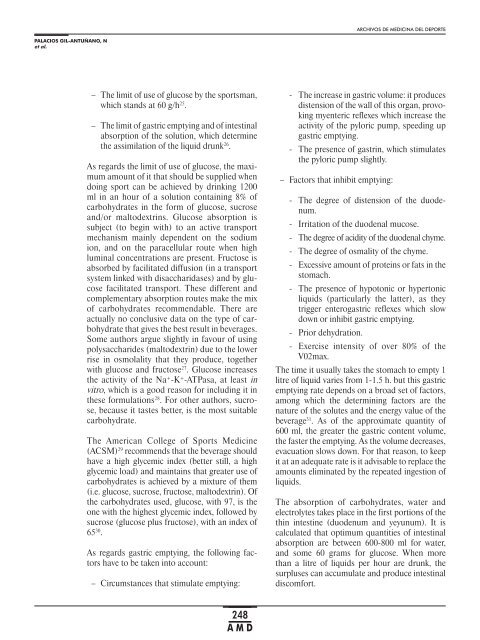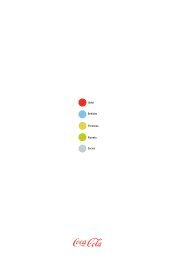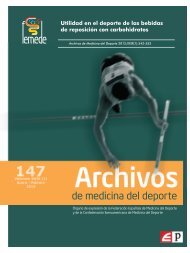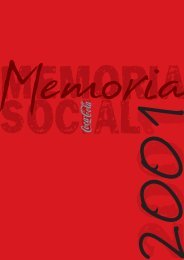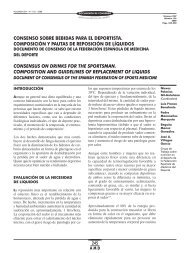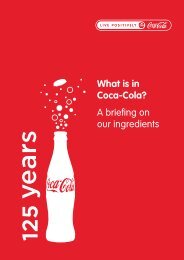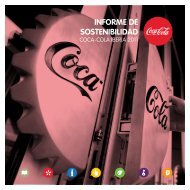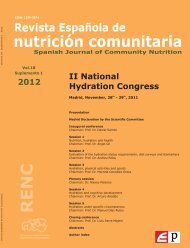de medicina del deporte - femede
de medicina del deporte - femede
de medicina del deporte - femede
You also want an ePaper? Increase the reach of your titles
YUMPU automatically turns print PDFs into web optimized ePapers that Google loves.
ARCHIVOS DE MEDICINA DEL DEPORTEPALACIOS GIL-ANTUÑANO, Net al.– The limit of use of glucose by the sportsman,which stands at 60 g/h 25 .– The limit of gastric emptying and of intestinalabsorption of the solution, which <strong>de</strong>terminethe assimilation of the liquid drunk 26 .As regards the limit of use of glucose, the maximumamount of it that should be supplied whendoing sport can be achieved by drinking 1200ml in an hour of a solution containing 8% ofcarbohydrates in the form of glucose, sucroseand/or malto<strong>de</strong>xtrins. Glucose absorption issubject (to begin with) to an active transportmechanism mainly <strong>de</strong>pen<strong>de</strong>nt on the sodiumion, and on the paracellular route when highluminal concentrations are present. Fructose isabsorbed by facilitated diffusion (in a transportsystem linked with disaccharidases) and by glucosefacilitated transport. These different andcomplementary absorption routes make the mixof carbohydrates recommendable. There areactually no conclusive data on the type of carbohydratethat gives the best result in beverages.Some authors argue slightly in favour of usingpolysacchari<strong>de</strong>s (malto<strong>de</strong>xtrin) due to the lowerrise in osmolality that they produce, togetherwith glucose and fructose 27 . Glucose increasesthe activity of the Na + -K + -ATPasa, at least invitro, which is a good reason for including it inthese formulations 28 . For other authors, sucrose,because it tastes better, is the most suitablecarbohydrate.The American College of Sports Medicine(ACSM) 29 recommends that the beverage shouldhave a high glycemic in<strong>de</strong>x (better still, a highglycemic load) and maintains that greater use ofcarbohydrates is achieved by a mixture of them(i.e. glucose, sucrose, fructose, malto<strong>de</strong>xtrin). Ofthe carbohydrates used, glucose, with 97, is theone with the highest glycemic in<strong>de</strong>x, followed bysucrose (glucose plus fructose), with an in<strong>de</strong>x of65 30 .As regards gastric emptying, the following factorshave to be taken into account:– Circumstances that stimulate emptying:- The increase in gastric volume: it producesdistension of the wall of this organ, provokingmyenteric reflexes which increase theactivity of the pyloric pump, speeding upgastric emptying.- The presence of gastrin, which stimulatesthe pyloric pump slightly.– Factors that inhibit emptying:- The <strong>de</strong>gree of distension of the duo<strong>de</strong>num.- Irritation of the duo<strong>de</strong>nal mucose.- The <strong>de</strong>gree of acidity of the duo<strong>de</strong>nal chyme.- The <strong>de</strong>gree of osmality of the chyme.- Excessive amount of proteins or fats in thestomach.- The presence of hypotonic or hypertonicliquids (particularly the latter), as theytrigger enterogastric reflexes which slowdown or inhibit gastric emptying.- Prior <strong>de</strong>hydration.- Exercise intensity of over 80% of theV02max.The time it usually takes the stomach to empty 1litre of liquid varies from 1-1.5 h. but this gastricemptying rate <strong>de</strong>pends on a broad set of factors,among which the <strong>de</strong>termining factors are thenature of the solutes and the energy value of thebeverage 31 . As of the approximate quantity of600 ml, the greater the gastric content volume,the faster the emptying. As the volume <strong>de</strong>creases,evacuation slows down. For that reason, to keepit at an a<strong>de</strong>quate rate is it advisable to replace theamounts eliminated by the repeated ingestion ofliquids.The absorption of carbohydrates, water an<strong>de</strong>lectrolytes takes place in the first portions of thethin intestine (duo<strong>de</strong>num and yeyunum). It iscalculated that optimum quantities of intestinalabsorption are between 600-800 ml for water,and some 60 grams for glucose. When morethan a litre of liquids per hour are drunk, thesurpluses can accumulate and produce intestinaldiscomfort.248A M D


